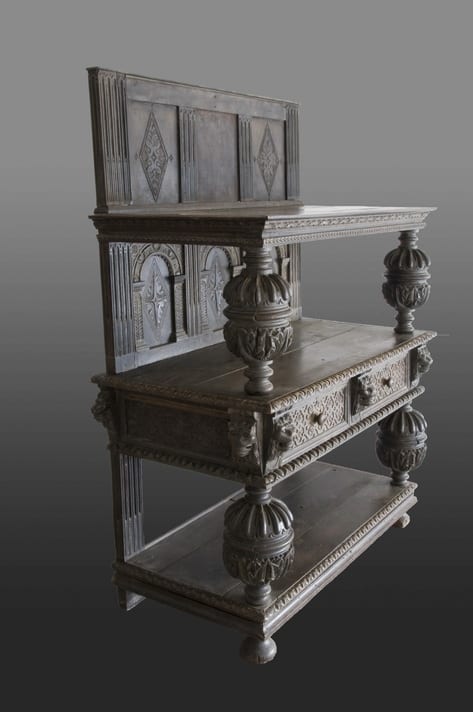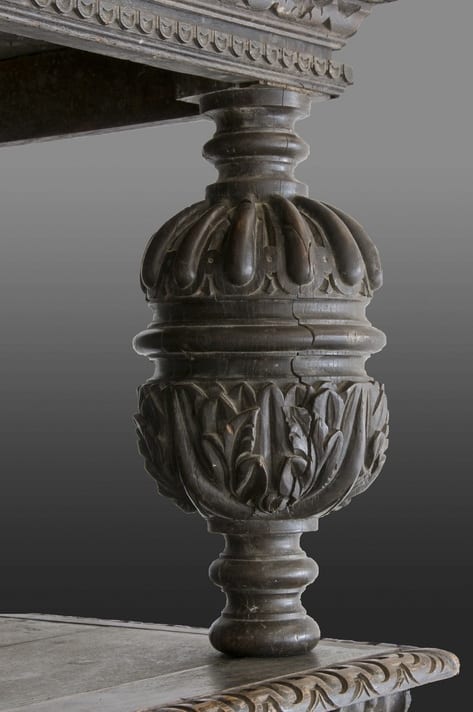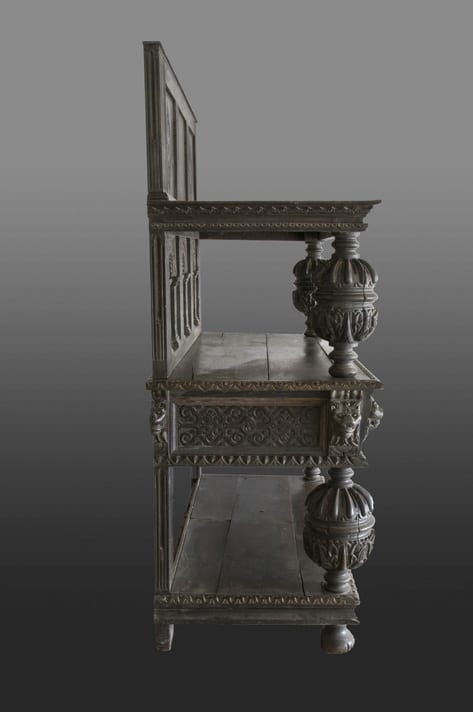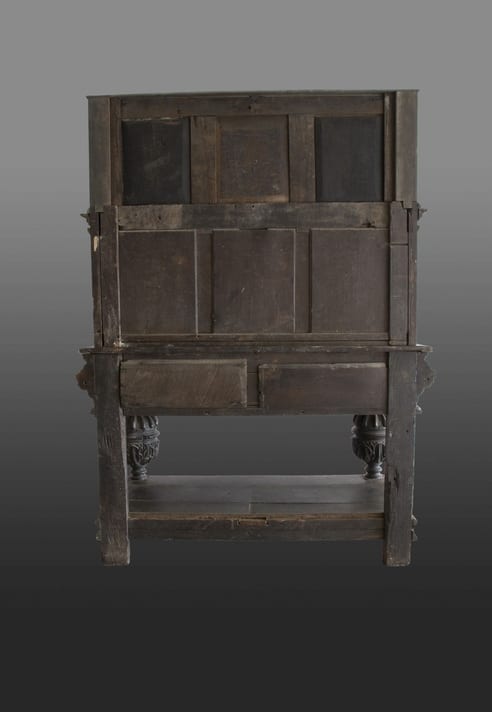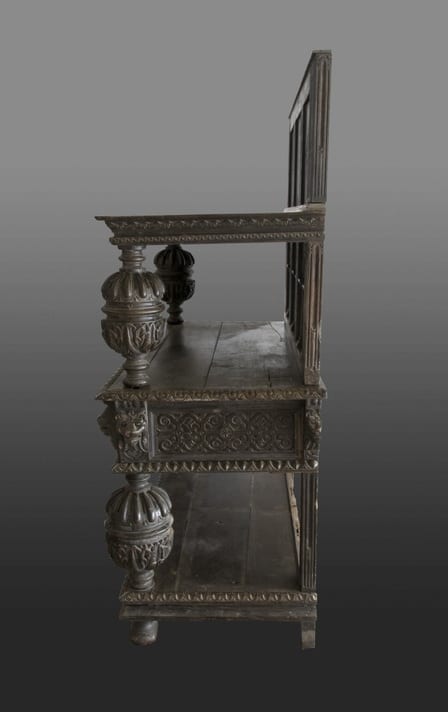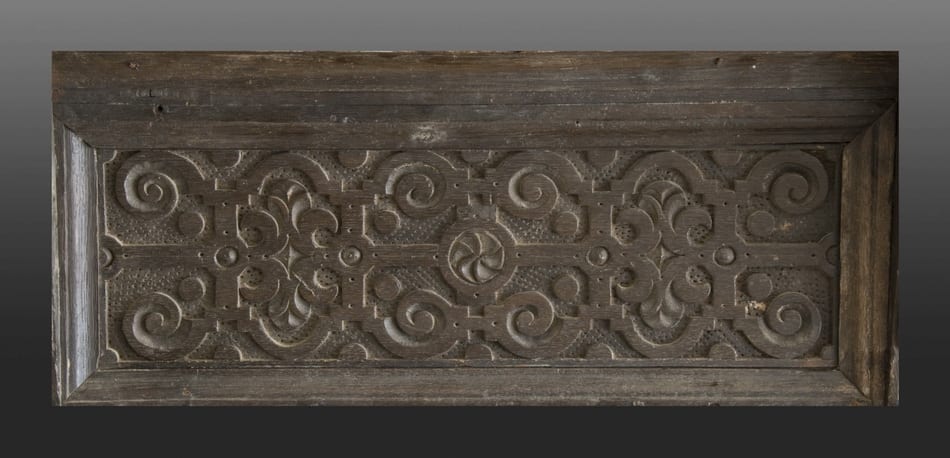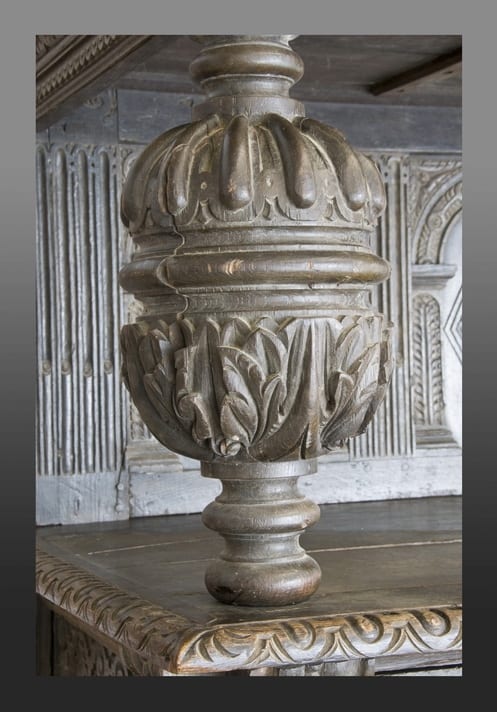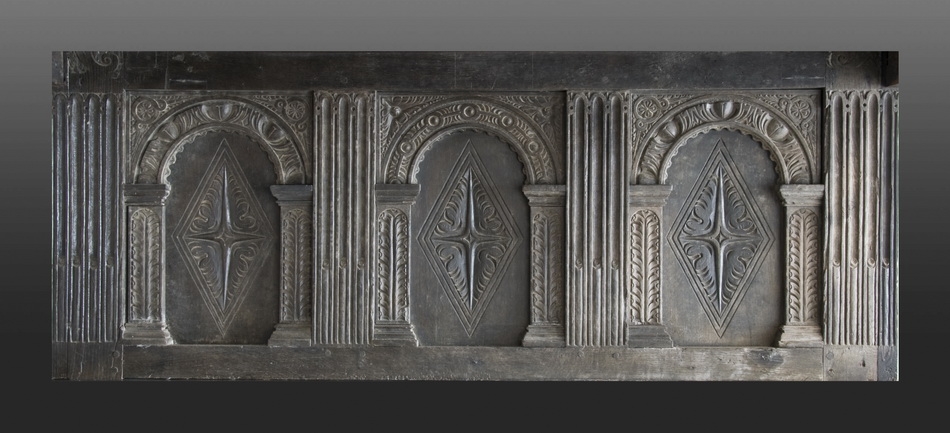Exeter at its most elaborate. Few but the most elite Exeter households could afford or accommodate a piece of joined furniture of such scale. This massive three-tiered cupboard was undoubtedly commissioned by a prosperous Exeter merchant during the height of the textile trade in the closing decade of the sixteenth century. The joiners responsible employed many of the ornamental strategies utilized on high-level fixed woodwork such as the Upper Hall of Tuckers’ Hall and the now destroyed ‘Oak Room’ of Bympfyld House. Courses of relief carved formalized strapwork, applied columns and arcades, fluted pilasters, three-dimensional lion mask corbels, and gadrooned frieze and cornice mouldings are here applied at nearly the a scale of and executed with precision equal to architectural work. It is a piece of movable architecture, not furniture. The top of the cupboard with its elaborated cornice supported by massive carved columns overhangs an open shelf behind which is are set three panels bearing arcades supported by Doric columns and flanked by pilasters. This configuration creates a visual which that captures the aesthetic and sense of perspective of a portico leading to a classicized façade. Similar arrangements of pseudo-architectural elements such as appear on the back panel of this cupboard and the overmantels at Tuckers’ Hall are employed on other known late sixteenth and early seventeenth-century elite-level Exeter joined furniture. This includes a standing press bearing the conjoined arms of the Exeter-based Dormer and Clifford families (Ralph Edwards, The Dictionary of English Furniture, vol. 3 (London: Antique Collectors Club, 2000), p. 158, fig. 5). The lion mask corbels which loom from the mid-shelf are identical to those applied in a similar location on what is likely the highest quality piece of Exeter joined furniture: a three-tiered open cupboard composed largely of bullet wood and inset with other subtropical hardwoods and feature columns carved in the form of heraldic beasts (Ashmolean Museum).
The cupboard demonstrates that even the most elite joiners and their wealthy clients did not escape the wood shortage that swept through Exeter. It was clearly constructed after severe depletion of the city’s primary local source of oak (Duryard Manor), the effects of which were felt beginning in the 1580s. The timber employed in the cupboard is the deep reddish colour of local oak identical to that used in cats. 2-3. Here the similarity ends. Despite the greater scale and thus cost of the cupboard when compared to lidded chests, the timber is relatively poor and scant – all work pieces are surprisingly thin and many show prominent imperfections. Shockingly how about uncharacteristically, virtually every framing member was originally intended for another purpose. Stiles, rails, and muntins exhibit open mortises, unexplained panel grooves, and previously bored pinholes. The section of paneling which encloses the rear of the upper shelf is composed entirely from the front of a chest with two drawers. The front stiles of this unfinished object now form the rear stiles of the upper tier of this two-piece cupboard and the tips of the chest’s stiles were shaped to tenons which now rest in mortises cut in the upper shelf, joining the upper and lower halves. These adapted components – the chest front included – appear to represent the work of the same artisans who constructed the cupboard. The timber is of identical character and the lozenge motifs on the chest-front are nearly the same as elements of a fully enclosed Exeter joined cupboard likely from the same workshop (Nyetimber Manor, Sotheby’s, 27 September, 2001, lot 1152). None of the components appear to have ever seen use in a completed object as the extra pinholes, mortises, and panel grooves are undisturbed and the second generation of work was conducted while the oak was still green. These components were most likely harvested opportunistically from a pile of discarded work pieces that accumulated in the shop as a result of mistakes or breakage. The chest-front may have been a project abandoned by a client who was unable or unwilling to see the contract through. Perhaps the owner of the cupboard changed his mind after commissioning a chest with drawers and decided instead to acquire the cupboard. The fact the Exeter joiners constructed an object of such high-level in this manner for a client for whom price was likely not a major consideration indicates the degree to which the wood shortages were felt by these artisans and demonstrates the lengths to which they went to compensate for this situation.
The cupboard records the sixteenth-century appearance of a carving design that is omnipresent on Thomas Dennis’ most elaborate and best documented works. Voids within the grid-like strapwork carved on faces of the two drawers and the side friezes which enclose the waist of the cupboard are filled with adorst trefoil motifs. These appear within similar strapwork on the four monuments of the Dennis shop: two joined great chairs and a carved box with drawer which descended in the Dennis family (Bowdoin College Museum of Art and Essex Institute) and a chest constructed for prosperous Ipswich, Massachusetts residents John and Margaret Staniford and dated 16‘76’ (Winterthur Museum).
Condition
Later enclosure of lower tier removed; minor losses to applied ornament; upper canopy restored using remaining components of original
